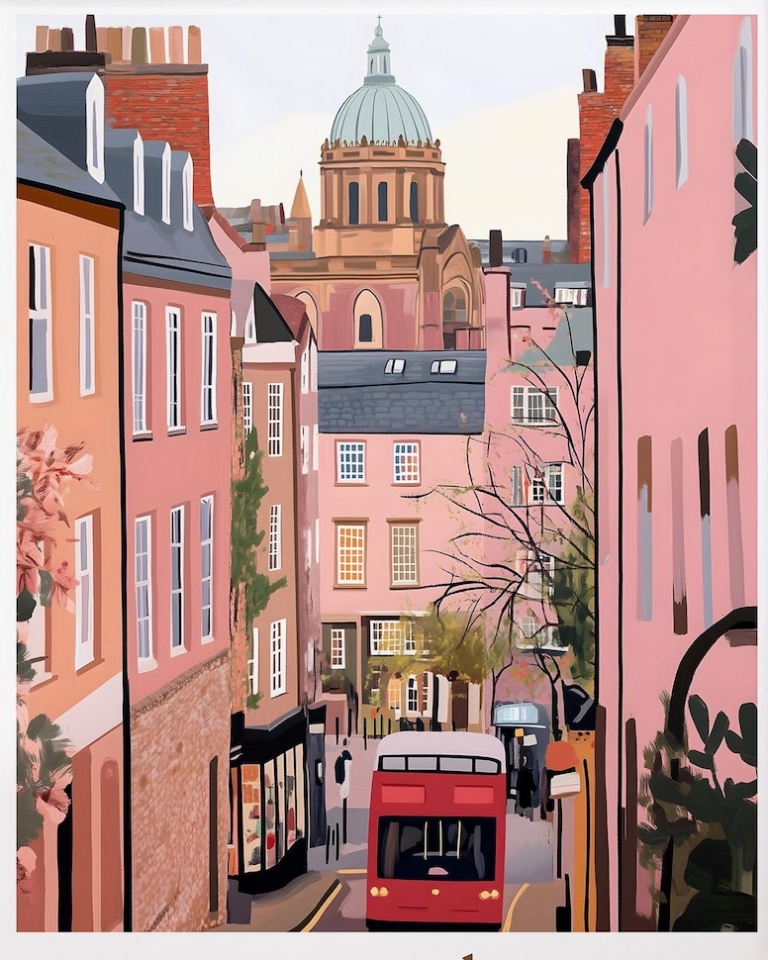
Chester is a city known for its striking old walls and handsome streets. It’s often called one of England’s most beautiful walled cities, with good reason. Here, you’ll find a lively mix of Roman roots, medieval buildings, and a friendly modern vibe.
From the famous Rows to ancient remnants and modern shops, Chester has layers of history to explore. This guide will walk you through the highlights, share local life, and help you enjoy everything that makes Chester special.
If walking in nature, always follow the Countryside Code, to keep dogs and barnyard friends safe. If visiting the nearby coast, read our post on keeping dogs safe by the seaside.
Chester’s Historic Roots
Wandering through Chester, you’ll notice how its long history still runs through daily life. The city began as a Roman stronghold and grew into a thriving medieval market centre.
Every corner shows how people have shaped Chester, from the old stone walls to the bustle of market streets. Let’s take a closer look at the roots that built this timeless city.
Roman origins and the walls
Chester began as Deva Victrix, a Roman fortress founded in AD 79. The Romans picked this spot for its strategic location, close to the River Dee and the border of Wales. Their fort was no simple outpost. Deva Victrix was a major base, once home to the legions who watched over north-west Britain.
The Romans built strong stone walls to protect their new settlement. These walls once marked the limits of the city, defending it from invaders and showing off Roman strength.
Over time, more layers were added, including extensions inspired by works like Hadrian’s Wall farther north. Chester’s original Roman ramparts set the pattern for the centuries that followed.
One of the best parts of Chester today is walking along the city walls. They’ve been rebuilt many times, but large parts still follow the first Roman lines. You can stroll right the way round, seeing views of the old city, the river, and the countryside beyond. Locals and visitors both love these elevated pathways.
Why are Chester’s walls special?
- England’s most complete city walls, mostly still walkable
- Offer clear views of historic sites, the Rows, the cathedral, and the racecourse
- Built on ancient Roman foundations, with medieval and Victorian repairs
It’s rare to find city walls so well preserved and so much a part of local life. They’re a real reminder that history is not just in museums here—it’s the path you follow through Chester itself.
Medieval market town
After the Romans left, Chester faded for a while, but the city sprang to life again in the Middle Ages. The Normans strengthened the walls and built a castle. Kings and merchants saw its value—Chester grew into a busy market town, thanks in large part to its market charter granted in 1200.
This charter allowed Chester to hold regular markets and fairs. People came from nearby villages, bringing goods to sell or trade. Craftsmen set up shops under the shelter of the Rows, and the city’s streets filled with the chatter of buyers and sellers. Life buzzed around the market square, much as it still does today.
The River Dee played a huge role. It was an ancient port route, linking Chester to Ireland, North Wales, and beyond. Goods arrived by boat, then moved through the bustling market districts. Ships brought in salt and wine.
Today, much of this trade and market spirit lingers. The layout of the streets follows old medieval lines. You can still hear the buzz of markets every week. Chester’s historic core is shaped by the rhythms of buying, selling, and meeting, just as it was centuries ago.
Iconic architecture and landmarks
Chester’s identity is shaped by the buildings lining its streets. Historic timber frames sit side by side with orange sandstone walls, mixing Roman, medieval, and Victorian influences.
You only have to wander the old centre to spot unique shopfronts, richly coloured stone, and echoes of the city’s ancient past. Let’s look at some of the landmarks and local building styles that make Chester special.
The Rows – two‑storey shopping galleries
The Rows are Chester’s most famous architectural feature, found nowhere else in Britain. These are covered walkways, raised above street level and running along the four main shopping streets. They create a double-layered effect: shops and cafés line both the ground floor and the upper gallery, protected from wind and rain.
Walking along The Rows, you can:
- Shelter in all weather, with timber and stone arches overhead.
- Glimpse original medieval beams, old shopfronts, and exposed brickwork.
- Discover a mix of independent boutiques, plus cafés tucked away above the bustle of street traffic.
Some sections feel straight out of a storybook, with sloping floors, black and white timbered facades, and glass displays full of crafts or sweets. These galleries began in the Middle Ages, giving traders a way to use limited space efficiently while letting customers browse even when it poured. Today, they hold:
- Quirky second-hand bookshops
- Artisan jewellery stores
- Cosy coffee nooks with window views
No visit to Chester feels complete without strolling along The Rows, popping into a shop for an antique or just watching the world go by from a wooden bench.
Triassic sandstone structures
Another thing you’ll spot in Chester is the warm orange glow of its older buildings. That colour comes from local Triassic sandstone, a type of stone quarried nearby for centuries. Builders used this soft yet sturdy rock for much of Chester’s historic heart, from the city walls to the cathedral and local homes.
Walking around, you’ll see:
- Historic churches and grand houses
- Weathered walls dotted with climbing ivy
- Sandstone civic buildings with deep-set windows
This stone makes Chester look as if it’s glowing at sunset, especially after rain. It’s not just pretty on the outside. The thick blocks keep interiors cool in summer and hold heat in the colder months, which mattered long before central heating.
A Roman Shrine and Amphitheatre
Tucked away in a quiet part of Chester, Minerva’s Shrine offers a unique link to the city’s Roman past. Carved into the sandstone wall of what was once a quarry, this small shrine honours Minerva, goddess of wisdom and war. While not grand, it stands out because it survived two thousand years almost as it was left—something rare outside Italy.
People passed by this spot on the way to the nearby Roman Amphitheatre, England’s largest. You can still visit the amphitheatre, which once echoed with the shouts of crowds and the clash of gladiators. Today, its grassy banks and partial stone remains host:
- Outdoor theatre shows
- Family events
- Historical displays explaining Roman life
Minerva’s Shrine and the amphitheatre link past and present. Actors now tread the same ground as Roman performers once did, making a walk through this corner of Chester feel like stepping back in time. Both sites remind locals and visitors alike that history isn’t just trapped in stone—it lives on in community life and culture here.
Chester today – community and commerce
Chester stays lively with local action, bustling shops, and a strong sense of togetherness. The city blends its past with new efforts, all while people work to create a fairer, greener, and more welcoming place for everyone. From fair-trade stalls to relaxing by the river, Chester’s heart still beats in its streets and along its waterfront.
Fair‑trade city initiatives
Chester doesn’t just talk about fairness—it acts on it. As one of the UK’s official Fairtrade Cities, the community backs fair pay and ethical production. Local shops show their support by stocking fair-trade coffee, chocolate, and handmade crafts. You spot the Fairtrade mark on shelves all over—independent shops, supermarkets, and even Chester Cathedral’s own café.
Markets in Chester highlight these values. Rows of stalls at the city market and pop-up events often showcase products that come straight from fair-trade co-ops across the world.
Many of the shopkeepers know the stories behind the goods they sell and are happy to chat about where things are made. School groups, local churches, and community leaders hold campaign weeks to boost knowledge about workers’ rights.
Key ways Chester promotes fair-trade:
- Annual Fairtrade Fortnight events throughout the city
- Local cafés brewing only fairly sourced tea and coffee
- Community-run co-ops using their profits for social projects
- Market stalls with crafts, textiles, and pantry staples supporting producers abroad
These efforts give Chester’s commerce a welcoming feel. Shopping here can often mean helping real families, not just grabbing a bargain.
River Dee and waterfront life
Life along the River Dee shapes how locals and visitors spend their time. The riverbank is a magnet for those who want to relax, enjoy nature, or find good food and drink.
River walks are easy to find. Footpaths meander from the Old Dee Bridge past tree-lined banks and pretty boat houses. Some stretches feel wild, with birds swooping over the water and rowers gliding past. Other spots open up to wide lawns and playgrounds, just right for a picnic.
Riverside cafés and food stalls add to the charm. Many have outdoor seating so you can watch boats and soak up the view. There’s nothing fussy here. The city’s riverside pubs offer spots for a slow pint, while some restaurants serve up meals made with local produce.
For those who want a closer look at the river, boat trips run daily. You can hop on a river cruise to see Chester from a fresh angle. Some boats carry you as far as the city outskirts or up to the Meadows, a quiet green space full of wildflowers and open skies. During summer, rowing clubs run races and the annual regatta fills the river with colour.
The river isn’t just for looking at. It’s a place that invites people out of their homes and makes Chester feel connected, alive, and close to nature.
Sharing Land More Fairly?
A large amount of this county is owned by the Duke of Westminster, including Eaton Hall. Who despite being born with ‘the longest silver spoon anyone could have’ is at least using some of his wealth to help the less fortunate in society. However there are calls for him to ban hunting on estates he owns (one creature was actually killed in someone’s garden, after the hunt pursued it onto private land)
Read more on why England could share land more fairly.
Conclusion
Chester stands out with its rare mix of ancient walls, local sandstone buildings, and a friendly community spirit. Each street tells a story, mixing Roman grit with medieval charm and today’s relaxed city life. The cafes, riverside paths, and unique shopping galleries draw you in, but it’s the sense of history in every step that gives Chester its lasting pull.
To truly get the feel of Chester, you need to walk the walls, visit the markets, and take your time in the city’s warm stone heart. If you want a place that balances old-world beauty with buzzing local life, Chester will not disappoint.






